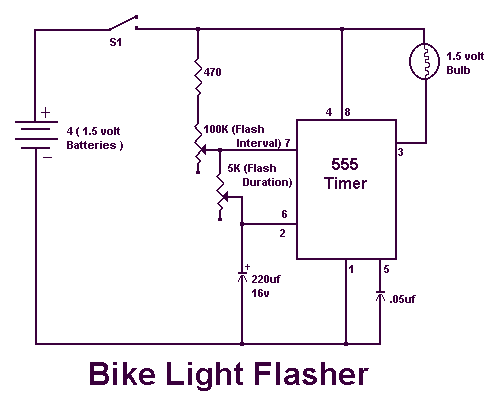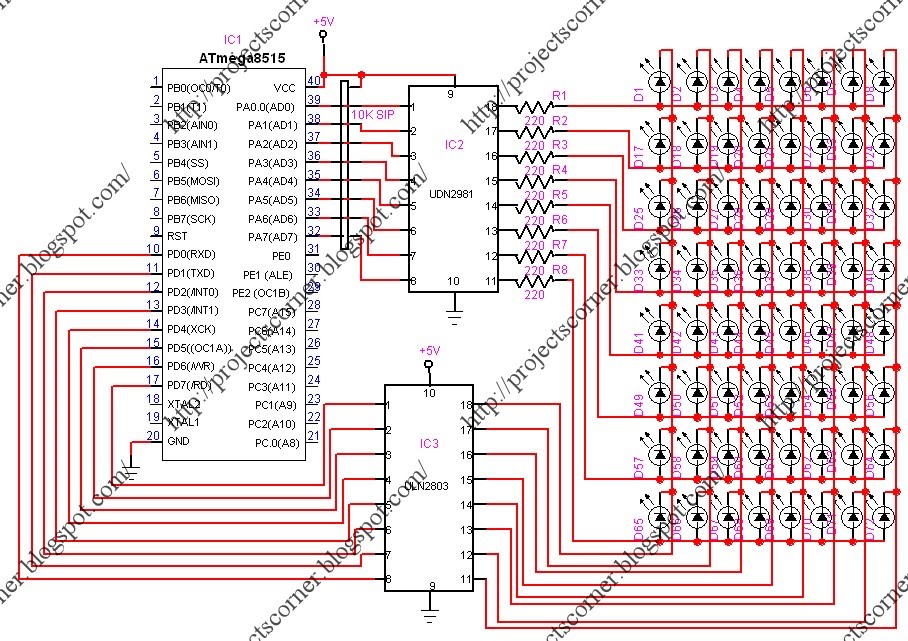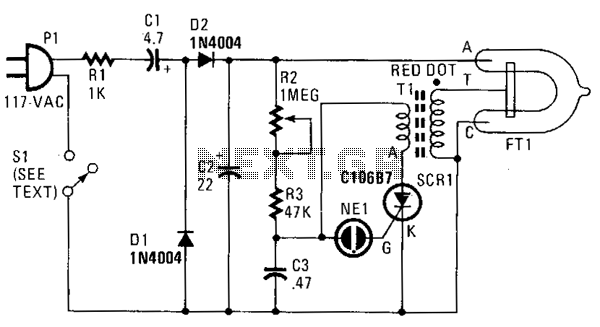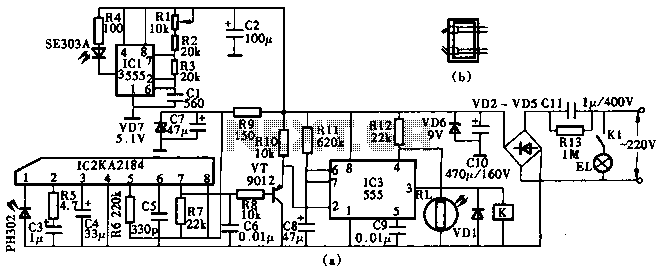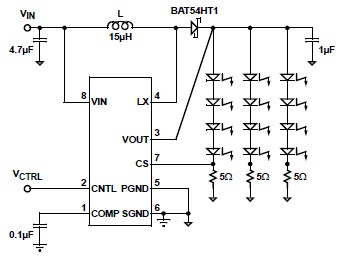
white light led driver with
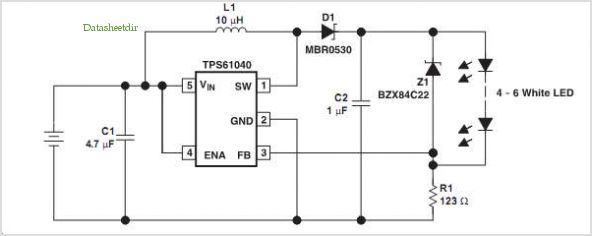
Many consumer products that utilize white light LEDs for illumination and backlighting offer gradual LED illumination during both turn-on and turn-off phases. This gradual illumination is typically achieved through a microprocessor that provides PWM dimming control. However, the following circuit employs the Texas Instruments TPS61040 white light LED driver to enable gradual illumination at turn-on and turn-off without relying on a microprocessor. This circuit generates a constant current of 101 mA to drive up to six white LEDs, suitable for portable applications such as PDAs and digital cameras. The input operating range is from 1.8 V to 6 V, accommodating two-cell alkaline and NiMH inputs (1.8 V to approximately 3 V), three-cell alkaline and NiMH inputs (2.7 V to approximately 4.8 V), and single-cell Li-Ion inputs (3 V to 4.2 V). The boost converter utilizes resistor R1 to establish a constant current through the LEDs. A detailed description of this circuit can be found in the TPS61040 data sheet (SLVS413).
The circuit design utilizing the TPS61040 white light LED driver is an efficient solution for providing consistent and gradual illumination for white LEDs in portable devices. The TPS61040 is a step-up (boost) converter that is specifically engineered to drive LEDs with a regulated constant current, ensuring uniform brightness across multiple LEDs.
The circuit begins by taking a low voltage input, which can range from 1.8 V to 6 V, and boosts it to the necessary voltage levels required to drive the LEDs. This feature is particularly beneficial for battery-operated devices, as it allows for the efficient use of power from various battery configurations, including alkaline, NiMH, and Li-Ion cells.
The resistor R1 plays a crucial role in setting the output current flowing through the LEDs. By selecting an appropriate value for R1, the desired constant current of 101 mA can be achieved, which is optimal for driving up to six white LEDs in series. This configuration not only simplifies the design by eliminating the need for a microprocessor but also enhances reliability by reducing potential points of failure.
The gradual illumination feature is implemented by controlling the switching frequency and duty cycle of the TPS61040, which can be adjusted to create a soft start and soft stop effect when powering the LEDs on and off. This approach minimizes sudden changes in brightness, leading to a more aesthetically pleasing user experience.
Overall, the TPS61040 circuit design represents a robust solution for LED driving applications, combining efficiency, simplicity, and effective current regulation to meet the demands of modern portable electronic devices. For further technical details and specifications, the TPS61040 data sheet (SLVS413) should be consulted.Many consumer products using white light LEDs for illumination and backlighting provide gradual LED illumination at turnon and turnoff. This gradual illumination is usually achieved with the aid of a Microprocessor that provides PWM dimming control.
This circuit uses the Texas Instruments TPS61040 white light LED Driver to provide gradual illumina tion at turnon and turnoff without the use of a Microprocessor The following circuit generates a 101mA constant current to drive up to 6 white LEDs for portable applications such PDAs and digital cameras. The input operating range is 1. 8 V to 6 V, which covers two-cell alkaline and NiMh inputs (1. 8 V to ~3 V), three-cell alkaline and NiMh inputs (2. 7 V to ~4. 8 V), and single-cell Li-Ion inputs (3 V~4. 2 V). This boost converter uses R1 to set a constant current through the LEDs A detailed description of this circuit CAN be found in the TPS61040 data sheet ( SLVS413 ).
🔗 External reference
The circuit design utilizing the TPS61040 white light LED driver is an efficient solution for providing consistent and gradual illumination for white LEDs in portable devices. The TPS61040 is a step-up (boost) converter that is specifically engineered to drive LEDs with a regulated constant current, ensuring uniform brightness across multiple LEDs.
The circuit begins by taking a low voltage input, which can range from 1.8 V to 6 V, and boosts it to the necessary voltage levels required to drive the LEDs. This feature is particularly beneficial for battery-operated devices, as it allows for the efficient use of power from various battery configurations, including alkaline, NiMH, and Li-Ion cells.
The resistor R1 plays a crucial role in setting the output current flowing through the LEDs. By selecting an appropriate value for R1, the desired constant current of 101 mA can be achieved, which is optimal for driving up to six white LEDs in series. This configuration not only simplifies the design by eliminating the need for a microprocessor but also enhances reliability by reducing potential points of failure.
The gradual illumination feature is implemented by controlling the switching frequency and duty cycle of the TPS61040, which can be adjusted to create a soft start and soft stop effect when powering the LEDs on and off. This approach minimizes sudden changes in brightness, leading to a more aesthetically pleasing user experience.
Overall, the TPS61040 circuit design represents a robust solution for LED driving applications, combining efficiency, simplicity, and effective current regulation to meet the demands of modern portable electronic devices. For further technical details and specifications, the TPS61040 data sheet (SLVS413) should be consulted.Many consumer products using white light LEDs for illumination and backlighting provide gradual LED illumination at turnon and turnoff. This gradual illumination is usually achieved with the aid of a Microprocessor that provides PWM dimming control.
This circuit uses the Texas Instruments TPS61040 white light LED Driver to provide gradual illumina tion at turnon and turnoff without the use of a Microprocessor The following circuit generates a 101mA constant current to drive up to 6 white LEDs for portable applications such PDAs and digital cameras. The input operating range is 1. 8 V to 6 V, which covers two-cell alkaline and NiMh inputs (1. 8 V to ~3 V), three-cell alkaline and NiMh inputs (2. 7 V to ~4. 8 V), and single-cell Li-Ion inputs (3 V~4. 2 V). This boost converter uses R1 to set a constant current through the LEDs A detailed description of this circuit CAN be found in the TPS61040 data sheet ( SLVS413 ).
🔗 External reference
